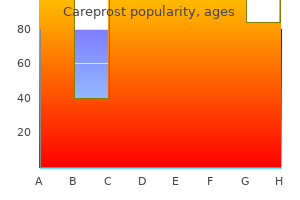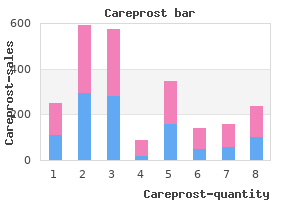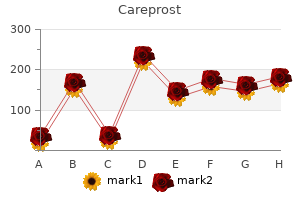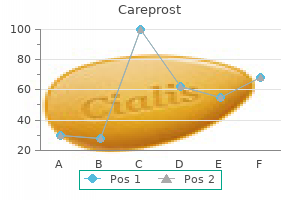CLINICAL,FORENSIC,AND ETHICS CONSULTATION IN MENTAL HEALTH
Careprost
"Order careprost paypal, symptoms zoning out".
By: D. Seruk, M.B.A., M.D.
Co-Director, Midwestern University Arizona College of Osteopathic Medicine
When oxidized symptoms 3 days past ovulation order careprost on line amex, it produces warmth to warm the blood flowing through the brown fats on arousal from hibernation and within the maintenance of physique temperature within the chilly treatment diabetes buy cheapest careprost. Brown adipose tissue is also current in nonhibernating animals and humans and once more serves as a source of heat symptoms 37 weeks pregnant 3ml careprost for sale. Therefore symptoms gallbladder discount careprost 3ml without a prescription, usually present brown adipose tissue can most likely be induced and function within the context of human adaptive thermogenesis. Future analysis is being directed towards discovering mechanisms for increased brown fat differentiation, which may doubtlessly be an the mitochondria in eukaryotic cells produce and store power as an electrochemical proton gradient across the inside mitochondrial membrane. The vitality produced by the mitochondria is then dissipated as warmth in a course of known as thermogenesis. The metabolic activity of brown adipose tissue is regulated by the sympathetic nerve system and is expounded to ambient outside temperature. In addition, chilly stimulates glucose utilization in brown adipocytes by overexpression of glucose transporters (Glut-4). An improve in the quantity of brown adipose tissue has been reported on the neck and supraclavicular regions during the winter months, especially in lean individuals. This is supported by post-mortem findings of bigger quantities of brown fats in outside workers exposed to chilly. Modern molecular imaging techniques now allow clinicians to precisely find the place brown fat is distributed in the body, which is important for proper differential diagnosis of cancerous lesions (see Folder 9. Exposure to chronic cold temperatures will increase the thermogenic needs of an organism. Studies have shown that in such a condition, mature white adipocytes can rework into brown adipocytes to generate body warmth. Conversely, brown adipocytes are able to rework into white adipocytes when the power stability is positive and the body requires a rise of triglyceride storage capability. This phenomenon, known as transdifferentiation, was observed in experimental animals. These findings are additionally supported by observations of differential gene expressions. Worth mentioning is the reality that mice with plentiful pure or induced brown adipose tissue are proof against weight problems, whereas genetically modified mice with out useful brown adipocytes are vulnerable to weight problems and type 2 diabetes. If the browning phenomenon is achieved by a physiologic genome-reprogramming mechanism, this mechanism might be used for future therapeutic methods aimed toward controlling the quantity of brown adipose tissue in the body. White-to-brown transdifferentiation of adipose tissue is induced by chilly exposure and bodily activity. Cold exposure and bodily activity induce conversion of white-to-brown adipocytes by way of several molecular pathways. Cold temperatures are sensed by the central nervous system, causing increased stimulation of the noradrenergic sympathetic nerve system. Physical exercise stimulation is extra complicated and involves the secretion of atrial and ventricular natriuretic peptides within the coronary heart that act on the kidney, which in flip activate transcription factors important for brown adipocyte differentiation. In the longer term, these signaling pathways and molecules concerned in adipocyte transdifferentiation may open new avenues in pharmacologic treatment of weight problems, diabetes, and different metabolic illnesses. White adipose tissue with supporting collagen and reticular fibers varieties the subcutaneous fascia, is concentrated in the mammary fat pads, and surrounds several inner organs. White adipocytes are very massive cells (100 m or extra in diameter) with a single, large lipid droplet (unilocular), a skinny rim of cytoplasm, and a flattened, peripherally displaced nucleus. Triglycerides stored in adipocytes are released by lipases which are activated during neural mobilization (involves norepinephrine released from sympathetic nerves) and/or hormonal mobilization (involves glucagon and growth hormone). Brown adipocytes are smaller than white adipocytes, comprise many lipid droplets (multilocular) and cytoplasm with a round nucleus. The metabolic exercise of brown adipose tissue is regulated by norepinephrine released from sympathetic nerves and is expounded to ambient outdoor temperature (cold weather will increase the amount of brown adipose tissue). It is a specialised connective tissue consisting of triglyceride-storing cells, adipocytes. Adipocytes catabolize triglycerides, and when energy expenditure exceeds power consumption, fatty acids are launched into circulation. In addition, glycerol and fatty acids launched from the adipocytes participate in glucose metabolism.

When injected into the nuclei of immature frog oocytes treatment zygomycetes 3 ml careprost fast delivery, which are normally arrested in G2 treatment ulcer purchase careprost on line, the cells immediately proceeded through mitosis treatment for 6mm kidney stone trusted careprost 3 ml. Cyclins are synthesized as constitutive proteins; nevertheless symptoms nausea headache fatigue discount careprost online amex, their ranges through the cell cycle are controlled by ubiquitin-mediated degradation. The increased exercise of cyclin� Cdk is achieved by the stimulatory motion of cyclins and is counterbalanced by the inhibitory action of proteins such as Inks (inhibitors of kinase), Cips (Cdk inhibitory proteins), and Kips (kinase inhibitory proteins). This diagram exhibits the altering sample of cyclin�Cdk actions during different phases of the cell cycle. Mitosis Cell division is a vital course of that will increase the number of cells, permits renewal of cell populations, and permits wound restore. The means of cell division includes division of each the nucleus (karyokinesis) and the cytoplasm (cytokinesis). The strategy of cytokinesis leads to distribution of nonnuclear organelles into two daughter cells. The chromosomes of maternal and paternal origin are depicted in red and blue, respectively. The mitotic division produces daughter cells which are genetically equivalent to the parental cell (2n). The meiotic division, which has two components, a reductional division and an equatorial division, produces a cell that has solely two chromosomes (1n). In addition, during the chromosome pairing in prophase I of meiosis, chromosome segments are exchanged, resulting in further genetic range. The facing surfaces of two sister chromatids seen on this picture form the centromere, a point of junction of each chromatids. On the opposite side from the centromere, every chromatid possesses a specialised protein complicated, the kinetochore, which serves as an attachment point for kinetochore microtubules of the mitotic spindle. Note that the floor of the chromosome has several protruding loop domains fashioned by chromatin fibrils anchored into the chromosome scaffold. The motion of microtubule-associated motor proteins on the microtubules of the mitotic spindle creates the metaphase plate alongside which the chromosomes align within the center of the cell. The sister chromatids are held together by the ring of proteins referred to as cohesins and the centromere. The nucleolus, which can nonetheless be current in some cells, additionally utterly disappears in prometaphase. Microtubules of the developing mitotic spindle connect to the kinetochores and thus to the chromosomes. The kinetochore is capable of binding between 30 and 40 microtubules to every chromatid. Kinetochore microtubules and � � their related motor proteins direct the movement of the chromosomes to a plane in the course of the cell, the equatorial or metaphase plate. This separation happens when the cohesins which were holding the chromatids collectively break down. The chromatids are then moved to reverse poles of the cell by microtubule-associated molecular motors (dyneins and kinesins) that slide alongside the kinetochore microtubules towards the centriole and are additionally pushed by the polar microtubules (visible between the separated chromosomes) away from each other, thus transferring reverse poles of the mitotic spindle into the separate cells. In the center of the cell, actin, septins, myosins, microtubules, and other proteins collect as the cell establishes a ring of proteins that can constrict, forming a bridge between the 2 sides of what was as quickly as one cell. The chromosomes uncoil and turn into vague besides at regions that stay condensed in interphase. The nucleoli reappear, and the cytoplasm divides (cytokinesis) to kind two daughter cells. Cytokinesis begins with the furrowing of the plasma membrane halfway between the poles of the mitotic spindle. The separation on the cleavage furrow is achieved by a contractile ring consisting of a very thin array of actin filaments positioned across the perimeter of the cell. The nuclear events of meiosis are the same in men and women, however the cytoplasmic occasions are markedly different. Therefore, the figure illustrates the variations in the course of as they diverge after metaphase I. In males, the 2 meiotic divisions of a main spermatocyte yield 4 structurally equivalent, although genetically distinctive, haploid spermatids.

The aspirate is then unfold as a smear on a glass slide and the specimen is examined with the microscope to examine particular person cell morphology symptoms nausea buy 3ml careprost amex. In bone marrow core biopsy treatment tracker discount careprost master card, intact bone marrow is obtained for laboratory analysis medications 3 times a day cheap careprost 3ml with visa. Usually a small incision is made in the skin to allow the biopsy needle to move into the bone symptoms thyroid buy 3ml careprost fast delivery. The biopsy needle is superior by way of the bone with a rotating movement (similar to a corkscrew motion through a cork) and later pulled out with a small, strong piece of bone marrow inside. After the needle is withdrawn, the core pattern is removed from the needle and processed for routine H&E slide preparation. It is often used to diagnose and stage various sorts of most cancers or monitor the results of chemotherapy. The proper facet of the image reveals disruption of the bony trabeculae, an indication of an artifact from needle insertion in the space close to the skin floor. The lighter, more eosinophilic area close to the tip of the core specimen with out evident bone marrow sample represents aspiration artifact. Photomicrograph (bottom) showing the next magnification of the world indicated by the rectangle above. The bone marrow on this patient appears to be normocellular (70% cellularity) with normal hemopoiesis (see Folder 10. The evaluation of bone marrow cellularity is semiquantitative and represents the ratio of hemopoietic cells to adipocytes. The most reliable analysis of cellularity is obtained from the microscopic examination of a bone marrow biopsy that preserves the organization of the marrow. As may be seen from this calculation, the variety of hemopoietic cells decreases with age. Deviation from age-specific regular indices indicates a pathologic change in the marrow. Thus, a 50-year-old particular person with this situation might need a bone cellularity index of 10% to 20%. In the same-aged individual with acute myelogenous leukemia, the bone cellularity index may be 80% to 90%. This is an example of hypocellular bone marrow from a person with aplastic anemia. The bone marrow consists largely of adipose cells and lacks normal hemopoietic activity. This photomicrograph of bone marrow section from an individual with acute myelogenous leukemia exhibits hypercellular bone marrow. Note that the whole subject of view subsequent to the bony trabecula is full of tightly packed myeloblasts. It consists of protein-rich liquid extracellular matrix known as plasma and fashioned components (white blood cells, purple blood cells, and platelets). Neutrophils (47% to 67% of all leukocytes) have polymorphic, multi- in blood clotting). There are three major forms of hemoglobin in adult people: HbA (96% of whole hemoglobin), HbA2 (3%), and HbF (1% but prevalent in the fetus). Their specific granules include numerous enzymes, complement activators, and antimicrobial peptides. Neutrophils go away circulation through postcapillary venules in a means of neutrophil�endothelial cell recognition. This involves cell adhesion molecules (selectins and integrins) and subsequent diapedesis (transendothelial migration) of neutrophils. Eosinophils (1% to 4% of all leukocytes) have bilobed nuclei and eosinophilic-specific granules containing proteins which may be cytotoxic to protozoans and helminthic parasites. Eosinophils are associated with allergic reactions, parasitic infections, and continual irritation. These substances play an necessary position in allergic reactions and persistent inflammations. Lymphocytes (26% to 28% of all leukocytes) are the primary functional cells of the immune system.


An argininerich protein discovered within the vesicles might be answerable for the extreme eosinophilic response symptoms ectopic pregnancy order 3 ml careprost overnight delivery. M cells have a very fascinating shape as a result of every cell develops a deep pocket-like recess connected to the extracellular space medicine for nausea order genuine careprost online. Due to this distinctive shape medicine 93 7338 buy cheap careprost on line, the basolateral cell floor of the M cell resides within a few microns of its apical floor medicine 8 - love shadow buy generic careprost 3 ml, significantly reducing the gap that endocytic vesicles should journey to cross the epithelial barrier. On their apical surface, M cells have microfolds rather than microvilli and a thin layer of glycocalyx. Within the recess, the launched content is straight away transferred to immune cells residing in this house. Thus, M cells function as highly specialized antigen-transporting cells that relocate intact antigens from the intestinal lumen throughout the epithelial barrier. Intermediate cells represent the amplifying compartment of the intestinal stem cell niche. Activation of taste receptors found on the apical cell membrane of "open cells" activates G protein�signaling cascade, resulting in releasing of peptides that regulate a selection of gastrointestinal capabilities. These embody regulating pancreatic secretion, inducing digestion and absorption, and controlling power homeostasis by performing on neural pathways of the brain-gut-adipose axis. Nearly the entire identical peptide hormones identified in this cell type in the stomach may be demonstrated in the enteroendocrine cells of the intestine (see Table 17. These cells represent the amplifying compartment of the cells which may be still capable of cell division and often bear one or two divisions earlier than they turn into committed to differentiation into either absorptive or goblet cells. These cells have brief, irregular microvilli with long core filaments extending deep into the apical cytoplasm and quite a few macular (desmosomal) junctions with adjoining cells. Small mucin-like secretory granules form a column within the heart of the supranuclear cytoplasm. Some remain throughout the local lymphatic tissue, but others may be destined for other websites within the body, such as the salivary and mammary glands. Recall that in the salivary glands, cells of the immune system (plasma cells) secrete IgA, which the glandular epithelium then converts into sIgA. Some experimental observations suggest that antigen contact necessary for the production of IgA by plasma cells occurs in the lymphatic nodules of the intestines. This may lead to growth not only of recent oral vaccines for infectious illnesses but also of the innovative therapy of tumors and inflammatory bowel illnesses. This perform has been partially clarified for the lymphatic nodules of the intestinal tract. The cells are readily recognized with the scanning electron microscope as a result of microfolds distinction sharply with the microvilli that represent the striated border of the adjacent enterocytes. This diagram shows the relationship of the M cells (microfold cells) and absorptive cells in the epithelium masking a lymphatic nodule. The M cell is an epithelial cell that displays microfolds rather than microvilli on its apical surface. It has deep recesses inside which lymphocytes, macrophages, and processes of dendritic cells come near the lumen of the small intestine. An intact antigen from the intestinal lumen is transferred throughout the skinny layer of the M cell apical cytoplasm to lymphocytes and other antigen-presenting cells residing throughout the recesses. Note that the world of the follicle coated by M cells is surrounded by the finger-like projections of the intestinal villi. The absence of absorptive cells and mucus-producing goblet cells in the space covered by M cells facilitates immunoreactions to antigens. In cooperation with the overlying epithelial cells, significantly M cells, the lymphatic tissue samples the antigens in the epithelial intercellular areas. Lymphocytes, macrophages, and different antigen-presenting cells course of the antigens and migrate to lymphatic nodules in the lamina propria where they undergo activation (see page 449), resulting in antibody secretion by newly differentiated plasma cells. An instance of a particular defense mechanism is the immunoglobulin-mediated response using IgA, IgM, and IgE antibodies.
Careprost 3 ml cheap. 戻ってきてよ SHINee(샤이니)僕のそばにだけいて(내 곁에만 있어)【歌詞付き / 日本語字幕】.
